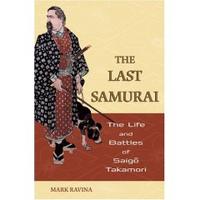Book Review
 The Last Samurai: The Life and Battles of Saigo Takamori, by Mark Ravina.
The Last Samurai: The Life and Battles of Saigo Takamori, by Mark Ravina.This is the true story of the last samurai, having very little in common with the recent movie of the same name. I should qualify "true" to say it's probably about as accurate as possible, because there are many debatable details about Saigo's life, made all the more difficult by subtle differences in translation from Japanese to English. In any case, Emory University professor Mark Ravina (yes yes Regis, we know) makes a good attempt at keeping the story interesting and moving forward, but I'm afraid that only serious students of Japanese history or asian studies are going to find this interesting. This really isn't light bedtime reading, and it may have as much to do with the editors at John Wiley & Sons (who publish a lot of university textbooks) as it does the fact that Japanese names and places are awfully damn hard for Westerners. The reason I mention the publisher is because I read another biography they published several years ago (Harford's Korolev) and distinctly remember thinking it was as dry as a textbook. Nevertheless, Saigo Takamori is one of the most important characters at one of the most interesting times in Japanese history. The destruction of the shogunate, the opening of Japan to the West, the elimination of the samurai class, and the reemergence of the Emperor as ruler all happened within a few short years near the end of the 19th century.
Comparing the book to the movie is apples to oranges, but it does have a bit of value. First, remember that the 'last samurai' in the movie is named Katsumoto. This is apparently an attempt by the filmmakers not to disparage Saigo's continued reputation as practically a diety. Second, note that the movie isn't really about Katsumoto, but the fictitious 'Captain Algren'. This is because the details of Saigo's life are actually pretty boring: He was born into one of the lower rungs of the samurai class and rose to political prominence through no specific heroic actions. Third, Katsumoto's primary antagonist is a reformer named Omura, and while Saigo and Omura were at one time opponents, the real Omura is such a minor character in Japanese history he almost didn't make it into the book. Saigo's actual opponents were often former allies, who later became friends again. Finally, the climactic battle at the end of the movie appears to take place in one battle on one day, while the actual battle was a full-fledged war (with cannons and rifles on both sides) that lasted nearly a year. Ravina's coverage of the Satsuma Rebellion (as it is most often called by historians) is covered in only the last 7 pages of the book, turning what should be the climax into an anticlimax. The two most interesting facts about the real last samurai are his attempted suicide and the fact that nobody really knows what happened to his head, removed in the honorable ritual seppuku (aka hara-kiri).
If you're interested in Japanese history, the only book I can recommend is Jansen's The Making of Modern Japan, a behemoth volume of nearly 1000 pages which unfortunately skips through the first 1000 years pretty quickly. If you're interested though, Jansen will get you up to speed on your Japanese names & places very quickly, not to mention being a more complete history than just the biography of one man.

4 Comments:
next time i need the report double spaced and hand delivered to my desk. :)
See? "Molvania" would have been a much more fun read! Should've listened...
I like the part of the movie where Captain Algren jumps up and down on Opra's couch. And then tells Brook Shields to suck it.
Al- You going to keep me after class?
Tonia- I started it last night, go warm up the Merde.
Regis- That must be on the DVD.
Post a Comment
<< Home